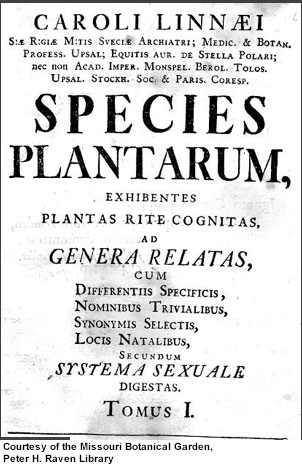
Activity 2 Home | Species Plantarum | Site 1 | Site 2 | Site 3 | Site 4 | Site 5
Species Plantarum
Carl Linnaeus published an account of all plant species known to him in 1753 in a volume that retroactively has become the starting point for botanical nomenclature: Species Plantarum. A particular innovation that makes this work notable is Linnaeus' consistent  use of binomials for the species he treated. Prior to Linnaeus, species were named by polynomials, descriptive names that often had to be changed as new species were discovered. In an age of rapidly expanding horizons and discovery of new taxa, the polynomial system quickly become unsustainable.
use of binomials for the species he treated. Prior to Linnaeus, species were named by polynomials, descriptive names that often had to be changed as new species were discovered. In an age of rapidly expanding horizons and discovery of new taxa, the polynomial system quickly become unsustainable.
For a naturalist in 1780 in the Carolinas, Species Plantarum would be the go-to work for the identification of species (the first flora of the Carolinas--Flora Caroliniana by Thomas Walters--would not be published until 1788). An interesting attribute of Species Plantarum is its arrangement. Species were not ordered according to a "natural" classification (based on perceived relationships or place in the "scala naturae"), but by morphology, particularly number of carpels and stamens. Although this facilitated identification, it was not without its problems. Linnaeus preferred to list congeners together, even when some species differed distinctly in number of parts. Thus, under the section "Triandria" (species with three anthers), one can find species of Valeriana exhibiting one, two, and three anthers. If one was simply trying to figure out what the species with one anther was but didn't know the genus to begin with, one somehow had to divine that others in the genus had three anthers to get to the right section.
In Species Plantarum, the oaks (Quercus) appear in the section "Monoecia, Polyandria". Navigate to this section and see for yourself. Take a moment and study how Linnaeus arranged this account. Note his use of Latin, a language that facilitated scientific communication at the time. Note also the use of the sharp s (similar to an "f" but the cross bar doesn't extend to both sides of the vertical line) vs. the regular s. Where did he place the specific epithet of each binomial? Where did he place the diagnosis? How many species of oaks were known to Linnaeus? How many from North America? How many from Europe?